Archived Storm Damage Blog Posts
3 Essential Steps for Deep Cleaning Your Home After a Flood
8/31/2024 (Permalink)
 Deep cleaning after flood in Bountiful, UT
Deep cleaning after flood in Bountiful, UT
Floods can be devastating, causing damage to homes and belongings while leaving behind a mess that can be challenging to clean. After ensuring your safety and addressing immediate concerns, the next crucial task is to deep clean your home to prevent further damage and restore it to its pre-flood condition. Here are three essential steps for deep cleaning your home after a flood:
1. Safety First: Assess and Prepare
Before diving into the cleaning process, it’s vital to prioritize safety. Floodwaters can carry harmful contaminants, and the risk of mold growth increases once the water recedes. Here’s how to start safely:
Inspect the Damage: Carefully assess the extent of the damage. Look for structural issues, such as warped floors or compromised walls, and check for hazards like exposed electrical wires. If the damage appears extensive, consider consulting a professional restoration service.
Wear Protective Gear: Equip yourself with safety gear, including gloves, masks, and waterproof boots. Floodwater can contain harmful bacteria, chemicals, and debris, so protection is crucial.
Turn Off Utilities: Ensure that the electricity and gas are turned off before you start cleaning. This prevents electrical hazards and further damage to your home’s systems. Contact a professional if you’re unsure how to safely turn off utilities.
Document the Damage: Take photos or videos of the damage for insurance purposes. This documentation will be valuable when filing claims and seeking compensation for repairs and replacements.
2. Remove and Clean Contaminated Items
Floodwaters can leave behind debris and contaminants that pose health risks and contribute to further damage. Efficiently removing and cleaning affected items is essential to restore your home. Here’s how to proceed:
Remove Standing Water: Use pumps, wet vacuums, or mops to remove any remaining water from floors and surfaces. Ensure the area is as dry as possible to prevent mold growth.
Discard Contaminated Items: Items such as carpets, furniture, and personal belongings that cannot be thoroughly cleaned and disinfected should be discarded. Mold and contaminants can be challenging to remove from porous materials.
Clean and Disinfect: For items that can be salvaged, thoroughly clean and disinfect them. Use a mixture of water and detergent to clean surfaces, followed by a disinfectant solution to kill bacteria and mold spores. Pay special attention to areas that were in direct contact with floodwater.
Dry Everything Thoroughly: Proper drying is crucial to prevent mold growth. Use fans, dehumidifiers, and open windows to enhance ventilation and accelerate drying. Ensure that all affected areas, including walls and floors, are completely dry before moving on to repairs.
3. Repair and Restore Your Home
Once your home is clean and dry, the next step is to address any repairs and restoration needed to bring it back to its pre-flood condition. This process involves:
Assess Structural Damage: Inspect walls, floors, and ceilings for damage. Look for signs of warping, cracking, or swelling. If you notice significant damage, consult a professional contractor to evaluate the repairs needed.
Address Mold and Mildew: Mold can begin to grow within 24-48 hours of water exposure, so it’s essential to address any signs of mold promptly. If you spot mold, use a mixture of water and detergent to scrub affected areas. For extensive mold problems, consider hiring a mold remediation specialist.
Repair and Replace: Begin repairing damaged structures and replacing any items that were beyond cleaning. This may include installing new drywall, replacing flooring, or fixing damaged insulation. Ensure that repairs are completed to a high standard to prevent future issues.
Prevent Future Flooding: To reduce the risk of future flooding, consider implementing preventive measures such as installing sump pumps, sealing basement walls, and elevating electrical appliances. Regular maintenance and inspection of your home’s drainage systems can also help prevent future water damage.
Deep cleaning your home after a flood is a crucial process that requires careful attention to detail and safety. By following these three essential steps—assessing and preparing, removing and cleaning contaminated items, and repairing and restoring—you can effectively address the aftermath of a flood and restore your home to its original condition. Remember, while these steps provide a general guide, each flooding situation is unique, and you may need to consult professionals for extensive damage or specialized tasks. At SERVPRO® , we understand the challenges of flood damage and are here to help you every step of the way, ensuring your home is clean, safe, and restored.
Restoring Hope: SERVPRO's Comprehensive Remediation Steps for Storm Damage in Bountiful, UT
7/3/2024 (Permalink)
 Storm Damage in Bountiful, UT
Storm Damage in Bountiful, UT
Storms are unpredictable and can wreak havoc on communities, causing extensive damage to homes and businesses. In Bountiful, UT, residents are no strangers to the destructive power of severe weather. When disaster strikes, timely and effective response is crucial to mitigate damage and restore normalcy. This is where we step in, offering professional storm damage remediation services that combine expertise, advanced technology, and a compassionate approach. Let's delve into the comprehensive steps we take to restore properties affected by storm damage in Bountiful, UT.
1. Emergency Contact and Rapid Response
The first step in our storm damage remediation process is ensuring immediate response. Storm damage can worsen quickly if not addressed promptly, so we provide 24/7 emergency services. When you contact us, a representative will gather essential information about the damage and dispatch a team to your location. This rapid response helps prevent further damage and sets the stage for an efficient restoration process.
2. Thorough Inspection and Assessment
Upon arrival, our highly trained technicians conduct a thorough inspection and assessment of the property. This step involves identifying the extent of the damage, potential safety hazards, and areas that require immediate attention. Using advanced moisture detection equipment, the team can pinpoint hidden water damage that might not be visible to the naked eye. This comprehensive assessment is critical in developing a tailored remediation plan.
3. Board-Up and Roof-Tarp Services
Storms can cause significant structural damage, including broken windows, compromised roofs, and damaged walls. To protect the property from further damage and unauthorized access, we offer board-up and roof-tarp services. These temporary measures help shield the interior from the elements and provide a safer environment for the restoration crew to work.
4. Water Removal and Drying
Water intrusion is a common consequence of storm damage, leading to potential mold growth and structural deterioration if not addressed quickly. We utilize powerful pumps and industrial-grade wet/dry vacuums to remove standing water from the property. Once the bulk of the water is extracted, specialized equipment, such as air movers and dehumidifiers, is deployed to dry affected areas thoroughly. This step is crucial in preventing secondary damage and mold infestation.
5. Debris Removal and Clean-Up
Storms often leave behind a trail of debris, including fallen trees, broken branches, and damaged building materials. Our team clear the site of all debris, ensuring safe and unobstructed access to the affected areas. This clean-up process also involves removing any hazardous materials and addressing potential biohazards to create a safe working environment.
6. Mold Remediation
In the aftermath of a storm, the presence of moisture can create an ideal environment for mold growth. Our technicians are trained in mold remediation techniques to identify and eliminate mold colonies. Using specialized cleaning products and equipment, the team removes mold and prevents its recurrence. This step not only protects the structural integrity of the property but also ensures a healthier living environment for the occupants.
7. Restoration of Structural Damage
Restoring the structural integrity of a storm-damaged property is a critical aspect of our remediation process. This step may involve repairing or replacing damaged roofs, walls, floors, and windows. Our work with skilled contractors and utilizes high-quality materials to ensure that the repairs meet industry standards. The goal is to restore the property to its pre-storm condition, making it safe and habitable once again.
8. Content Restoration and Cleaning
Personal belongings and valuable items can suffer damage during a storm. We offer comprehensive content restoration services to salvage and restore these items. Using specialized cleaning techniques and equipment, the team cleans, sanitizes, and deodorizes affected belongings. This step not only helps preserve sentimental items but also reduces the overall cost of replacement.
9. Odor Removal
Storm damage can leave behind unpleasant odors due to water intrusion, mold growth, and debris. We employ advanced deodorization techniques to eliminate these odors, ensuring that the property smells fresh and clean. This step involves using industrial-grade air scrubbers, thermal foggers, and other odor-neutralizing equipment to remove lingering smells.
10. Final Inspection and Quality Assurance
Once the remediation and restoration processes are complete, we conduct a final inspection to ensure that all work meets their high standards of quality and safety. This step involves a thorough review of the property to confirm that no issues have been overlooked. The team addresses any remaining concerns and ensures that the property is fully restored and ready for occupancy.
11. Insurance Claim Assistance
Navigating the insurance claims process can be overwhelming, especially in the wake of a storm. We assist clients in documenting the damage and provides detailed reports to support insurance claims. This step ensures that clients receive the compensation they deserve and helps expedite the claims process.
12. Ongoing Support and Monitoring
Even after the immediate remediation and restoration are complete, we continue to offer support and monitoring. The team provides guidance on preventative measures to protect the property from future storm damage and conducts follow-up visits to ensure that no issues arise post-restoration.
In Bountiful, UT, where storms can cause significant disruption and damage, we stand as a reliable partner in the recovery process. Their comprehensive storm damage remediation steps, from emergency response to final inspection, demonstrate a commitment to quality, safety, and customer satisfaction. By choosing us, residents and business owners can rest assured that their properties are in capable hands, and their journey to recovery will be handled with care and professionalism. When storms strike, we are there to help restore hope and rebuild communities.
Mastering the Art of Winter Home Maintenance: A Guide to Preventing and Dealing with Frozen Pipes
12/28/2023 (Permalink)
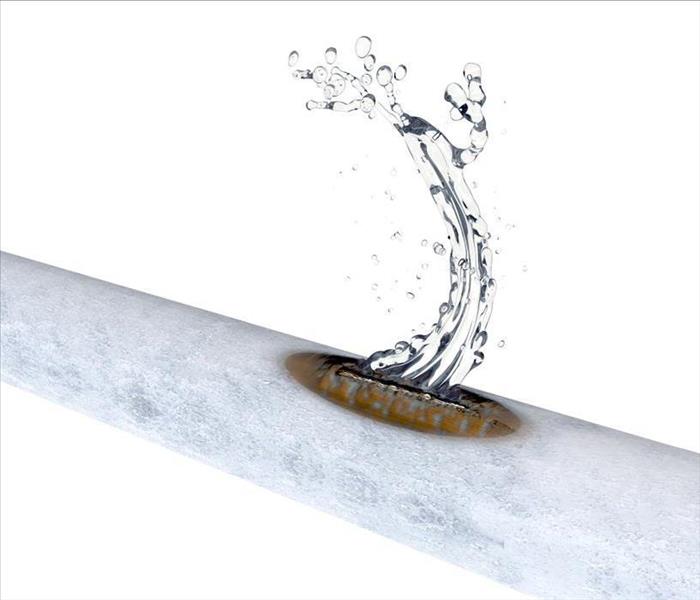 A frozen pipe in Bountiful, UT.
A frozen pipe in Bountiful, UT.
As winter descends upon the charming city of Bountiful, Utah, homeowners brace themselves for the challenges that come with plummeting temperatures. One of the most common and potentially damaging issues during the winter months is the freezing of pipes. In this comprehensive guide, we will delve into the proactive measures you can take to prevent frozen pipes and offer expert advice on thawing them if the need arises. Embrace the winter wonderland while safeguarding your home with these essential tips.
Understanding the Threat:
Why Do Pipes Freeze?
Before we delve into prevention strategies, it's essential to understand why pipes freeze in the first place. When temperatures drop, especially during cold snaps common in Bountiful, the water inside pipes can freeze, leading to expansion. This expansion creates pressure within the pipes, and if it becomes too intense, it can cause them to burst. Burst pipes can result in water damage, structural issues, and costly repairs. Now, let's explore practical steps to prevent this winter woe.
6 Steps To Prevent Frozen Pipes
1. Invest in Comprehensive Insulation: Shielding Your Pipes from the Cold
As the first line of defense, insulation plays a pivotal role in protecting your pipes from the harsh winter chill. Conduct a thorough inspection of your home, paying close attention to areas where pipes are exposed, such as attics, basements, and crawl spaces. Wrap pipes with pipe sleeves, use heat tape, or apply foam insulation to create a barrier against the cold. Remember, the investment in quality insulation can pay off in the long run by preventing potential damage and reducing energy costs.
2. Embrace the Drip: Allowing Faucets to Flow
On exceptionally cold nights, consider letting faucets connected to vulnerable pipes drip slowly. This continuous flow of water disrupts the formation of ice within the pipes, lowering the risk of freezing. While this may lead to a minor increase in water usage, it's a small price to pay compared to the potential damage caused by frozen and burst pipes.
3. Seal the Gaps: Locking Out the Cold
Leaks and gaps in your home's structure can allow cold air to infiltrate, putting your pipes at risk of freezing. Conduct a thorough inspection of your home's exterior, including windows, doors, and the foundation. Seal any cracks or gaps using caulk or weatherstripping to fortify your home against the winter chill. By maintaining a tight envelope, you create a warmer environment for your plumbing system.
4. Strategic Use of Space Heaters: Targeting Trouble Spots
Strategically placing space heaters in key areas of your home can be an effective preventive measure. Focus on spaces where pipes are most vulnerable, such as basements, attics, and crawl spaces. However, it's crucial to use space heaters safely and responsibly, following manufacturer guidelines and never leaving them unattended. When used correctly, these heaters can provide an extra layer of warmth to protect your pipes from freezing temperatures.
5. Open Cabinet Doors: Enhancing Airflow in Enclosed Spaces
For pipes located beneath sinks, especially in kitchens and bathrooms, leaving cabinet doors open during colder nights can promote better airflow. This allows warmer air to circulate around the pipes, reducing the likelihood of freezing. For additional airflow enhancement, consider using a small fan in enclosed spaces to maintain a consistent and warmer temperature.
6. Thawing Frozen Pipes: A Gentle Approach is Key
In the unfortunate event that you discover frozen pipes, it's essential to thaw them gently to avoid causing further damage. Never resort to excessive heat or open flames, as this can lead to burst pipes. Instead, use a hairdryer, heating pad, or towels soaked in hot water to apply gentle heat to the affected area. Start at the faucet and work your way towards the blockage, exercising patience throughout the process. This careful approach helps prevent potential water damage and preserves the integrity of your plumbing system.
Winterizing Your Home for a Stress-Free Season
As winter settles in Bountiful, Utah, and the landscape transforms into a snowy wonderland, your home should be a warm and secure haven. By implementing these comprehensive strategies, you not only shield your pipes from the threat of freezing but also ensure a comfortable and stress-free winter for you and your family. From insulation and strategic heating to proactive measures like letting faucets drip, mastering the art of winter home maintenance is the key to a worry-free season. Embrace the beauty of winter while safeguarding your home—because with the right precautions, you can enjoy the magic of the season without the fear of frozen pipes. Stay warm, stay prepared, and let your home be a sanctuary in the midst of winter's embrace.
Stop Mold in Its Tracks After a Home Flood
8/31/2023 (Permalink)
 A flooding can cause severe damage to your home.
A flooding can cause severe damage to your home.
Mold is virtually everywhere all the time; there's really no getting away from it. However, most of the time, it doesn't cause problems. If your floodwaters enter your Bountiful, UT, home, though, a mold problem can develop quickly and can get out of hand fast. Mold growth will begin approximately 24-48 hours after water exposure, so it's essential to start the remediation process as soon as possible.
How to prevent mold growth
- Wear Personal Protective Equipment
Before you begin the cleanup process, whether you know there is mold or not, it's vital to wear PPE to protect yourself from whatever is in the water, whether mold, bacteria, or harmful chemicals. Safety goggles, respirators, and gloves are the minimum gear you should wear. You can also wear hair covers, coveralls, and shoe covers for a more severe job.
- Let the Fresh Air In
If the humidity outside is less than the relative humidity in the house, open windows and doors to let some fresh air blow through. You can begin using fans and dehumidifiers to help the drying process along.
- Extract All Excess Water
The easiest way to remove all standing water is with a wet/dry vacuum. If you don't have one, you can rent one at a hardware or home improvement store. Mops and towels will also do the job, but a wet/dry vacuum is the easiest and most efficient way to quickly extract the water and small, floating debris.
- Remove Soaked Materials
All soaked materials that can be removed must be removed. Wet items will just add to the excess moisture of the area, further promoting mold growth. Anything porous, including wooden and upholstered furniture, carpeting and padding, drywall, insulation, papers, and stuffed toys, are just a few of the items that will be affected by floodwaters and moisture. Anything that can't be completely dried within 24-48 hours will generally not be salvageable.
- Inspect for Mold
Next, it's essential to inspect for mold. You might smell a musty odor but see no signs of mold. Still, if you smell this odor, mold is probably growing somewhere in the area. Some areas to look for mold are on baseboards, ceilings, under flooring, and behind drywall. The only sure way to find all the mold, if there is any, is to hire mold remediation experts to do a thorough professional inspection.
- Clean and Disinfect Everything
Next, it's time to clean and disinfect the affected area. If you discover mold, a detergent and clean water will get rid of it and help prevent it from coming back.
- Dry Everything Completely
Finally, it's essential to dry the area completely before doing structural repairs or moving belongings back into place. You can run fans, heaters, dehumidifiers and open the windows and doors.
When you experience a home flood, drying everything is one of the most essential tasks to begin immediately. Removing the standing water and excess humidity within 24-48 hours will help minimize or even totally avert mold growth. Once you've finished all your restoration work, have a final inspection performed to ensure no mold remains.
3 Steps for Deep Cleaning Your Home After a Flood
9/8/2022 (Permalink)
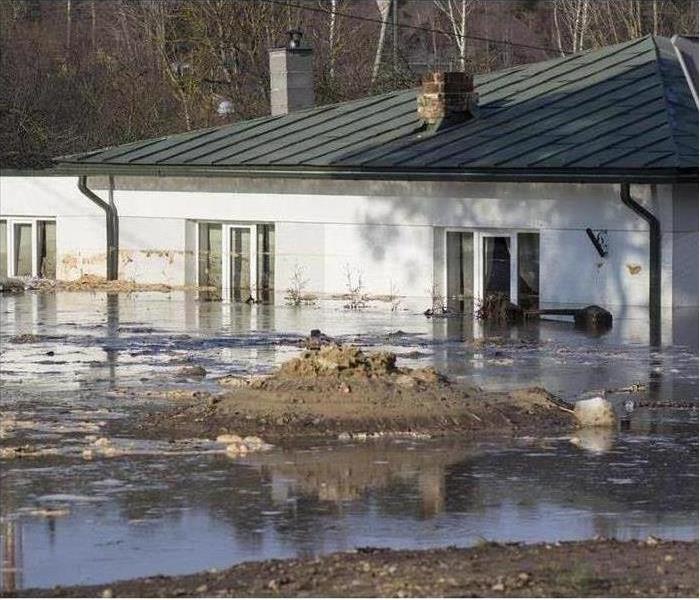 Flood Damage can leave mud and debris behind in your homes.
Flood Damage can leave mud and debris behind in your homes.
Flooding in Bountiful, UT, can wreak havoc on your home, especially when it comes to the mud, sludge, and debris it leaves behind. Cleaning walls, floors, and all your belongings once the waters recede can seem like an impossible task, especially if you must follow specific cleaning requirements from your insurance company, city, or state.
Steps to Take For Flood Cleanup
1. Begin With Hard Surfaces
Once you call your insurance agent and storm damage and flood restoration company to handle the drainage and disposal of contaminated floodwaters, you can begin cleanup efforts by creating a flood disinfectant for your home’s hard surfaces. Use clean scouring pads and a maximum-strength cleanser on your kitchen counters and other surfaces, then disinfect them with bleach or other germicide diluted with hot water. Remember to ventilate the room when you work with these chemicals and wear a mask and gloves to protect yourself.
2. Disinfect Your Kitchen Goods
Once your surfaces are clean, you can move on to your dishes, silverware, and canned goods. China, glassware and plastic utensils can be soaked in hot water treated with disinfectant, while metal silverware and cookware can be cleaned by immersing them in boiling water for 10 to 15 minutes. Avoid using bleach on metal surfaces, as it may cause your items to stain or discolor. Remove labels from your canned goods, allow them to soak in disinfectant, and then air dry before you re-label them.
3. Sort Salvage From Trash
If you are following specific cleaning requirements from a local authority, it is important that you understand which items can be salvaged and which must be thrown away. As you were flooding clean, make piles of items that can be restored, such as non-porous toys and tools, and throw away mattresses, soaked bedding, and plastic toys that may have absorbed contaminated water.
Flooding in Bountiful, UT, can leave behind mud, debris, and soaked belongings. Following your city’s cleaning requirements and knowing where to begin may make the cleanup process simpler and give you peace of mind as a homeowner.
6 Ways to Reduce Your Home’s Flood Risk
8/10/2022 (Permalink)
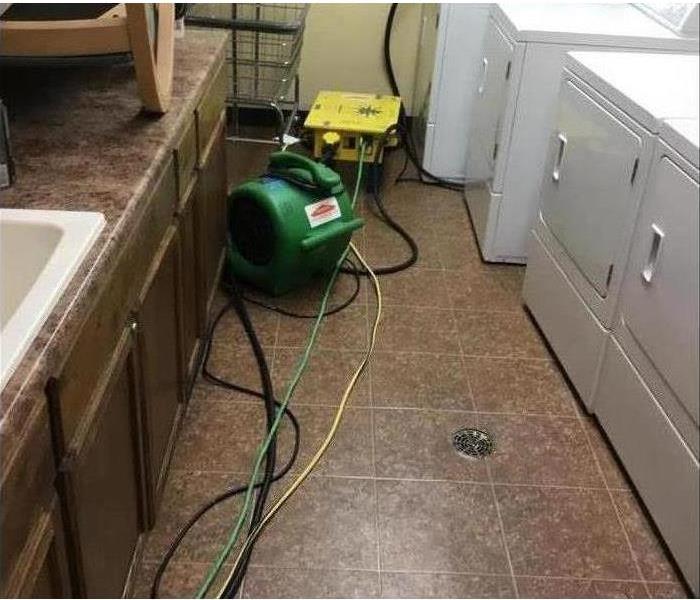 Air mover on laundry room floor after suffering storm damage in Bountiful, UT.
Air mover on laundry room floor after suffering storm damage in Bountiful, UT.
Floods are often unavoidable. Although you may not be able to fully flood-proof your home, every homeowner in Bountiful, UT, can take proactive prevention and flood safety measures to protect their properties against extensive flood damage.
Flood Safety
1. Prepare Sandbags
If you receive adequate warning of an approaching storm capable of producing significant rainfall, such as a hurricane, create an external barrier with sandbags, which can divert water from your residence.
2. Install a Sewage Water Backstop and a Sump Pump
A sewage water backstop is an efficient flood safety device that prevents backwater from flowing into your basement. A sump pump is another beneficial machine that can drain water out of your home.
3. Assess Basement Windows and Your Foundation
A cracked foundation may enable water to flow inside your basement. Water can also seep through basement windows. To secure these areas, ensure that windows are properly caulked and sealed and repair any existing foundation issues.
4. Maintain Gutters
Routinely clean your gutters to prevent blockages that may restrict water flow. In addition, install downspout extensions to direct water farther away from your home’s foundation.
5. Plant Grass and Use Mulch
Both mulch and grass absorb water. So planting grass around your home and placing mulch around external foliage provides an additional flood safeguard. However, to ensure retained moisture does not damage siding, keep mulch at least six inches away from your home’s exterior.
6. Properly Grade Soil
Grading the ground away from your home is another efficient safety tip that also helps divert water away from your foundation.
Peace of Mind
Following these seven flood safety tips helps reduce your home’s flood risk. However, it is impossible to fully eliminate the threats of extreme weather and bursting pipes. For this reason, the best flood safety measure is a flood insurance policy, which provides financial security and ensures that you have funds available to cover cleanup and restoration costs and replace destroyed property.
Steps of the Roof Repair Process After a Storm
7/19/2022 (Permalink)
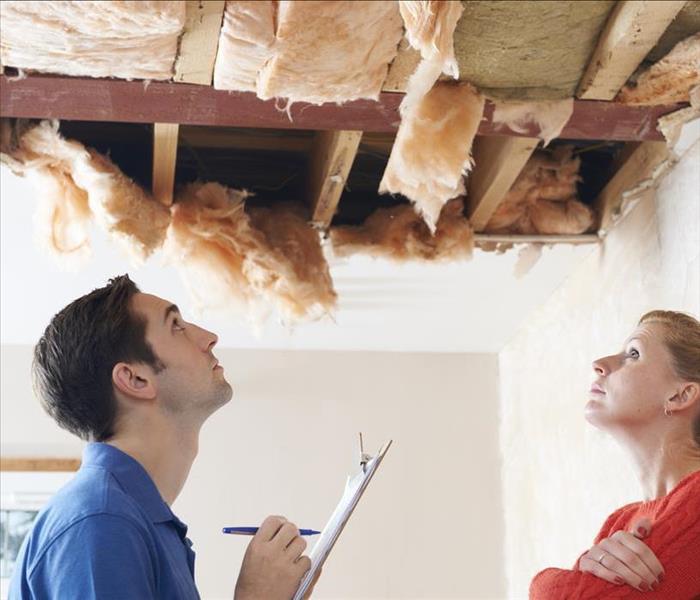 Storm causes roof damage.
Storm causes roof damage.
When a strong storm blows through Bountiful, UT, your roof and other areas of your home may get damaged. The exterior problems you see are probably not the only ones that the downpour and gusts left behind. It is in your best interest to make sure your home and roof repair get started right away.
The Roof Damage Repair Process
You may notice missing shingles or holes in your roof after a particularly heinous storm. Before you fix this problem, however, you should call storm damage mitigation experts to repair the issues that it caused inside your attic. The technicians board up the holes in your roof so that no further rain or wind damage occurs. Then they begin the interior remediation process.
1. Remove
Any portion of your attic that was touched by rain or debris may have damage. In addition to pumping out any standing water that is left behind, the mitigation specialists start cleanup by removing all materials that cannot be salvaged:
- Insulation
- Drywall
- Warped wood
- Carpet
- Floor pads
It is important to remove waterlogged materials promptly. Failure to do so can result in secondary damage such as rot or mold growth.
2. Clean
Your attic must be cleared of any dirt or debris that blew in with the storm. In most cases, technicians will also disinfect remaining surfaces to ensure that any bacteria from the rain are gone before roof repair gets started. This step also helps the team verify that no more ruined materials are present.
3. Dry
The way storms cause so much damage is by letting excess moisture into your home. Even if there is no standing water, the roof leak likely left things damp and increased the humidity. Prevention of further damage depends on the remediation team making sure all remaining surfaces are dry. Additionally, dehumidifiers can be used to bring the interior humidity back to an acceptable level.
4. Rebuild
Anything that was removed from your attic is probably something you want to replace. The rebuilding process involves not only installing new insulation, drywall and flooring but also making sure that the new materials match the remaining ones. By the time the restoration team is finished, you shouldn't be able to tell where the storm damage was.
5. Repair
After all the interior issues have been resolved, it's finally time to repair the roof damage caused by the storm. The roofing expert you hire starts by inspecting the roof to identify all the problems. If your insurance provider covers the cost of the damage, be sure to get an estimate before the work is started so that you can use it to document your claim. Fully repairing the roof is necessary to avoid further damage to your home.
Cleaning up after a storm is usually a multi-tiered process. If your house needs roof repair, you probably need to begin by fixing all the damage from the rain and wind that entered your home through its vulnerable spots. Once the mitigation inside your house is complete, then the roof can be fixed so that your attic is protected.
How To Make a Flood Claim After a Storm
5/25/2022 (Permalink)
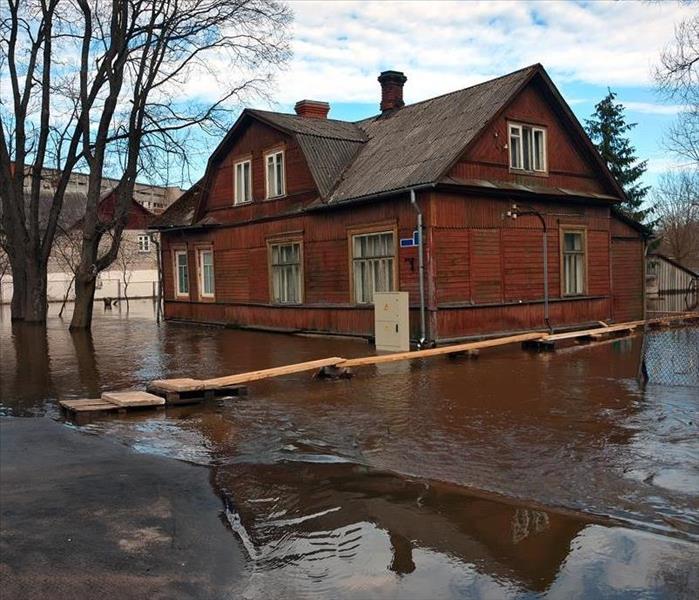 We help you to Make a Flood Claim After a Storm. Just follow Our Tips.
We help you to Make a Flood Claim After a Storm. Just follow Our Tips.
If a storm damages your Bountiful, UT, home, you likely will not be able to afford the repairs yourself. Luckily, your flood insurance policy should help you pay for emergency restoration services. To ensure that your flood claim is approved, follow the below steps:
4 Steps for Filing an Insurance Claim
1. Call Your Insurer
First, you must tell your insurance provider about the flood in your home. You can easily find the insurer’s phone number online. You will also likely have to notify your provider about the loss in writing. Before you contact the insurer, be sure to have your policy number handy.
The insurance representative will ask you for this information over the phone. You will also need to provide contact information and your mortgage company, if applicable.
2. Prepare for the Adjuster and Other Visitors
The insurance company will send an adjuster to your home to examine the damage. Before he or she arrives, take videos and photos of the affected areas. Be sure it is safe to re-enter your home first. The images should show the height of the floodwater, the structural damage to the house, and any personal items that were harmed.For larger appliances and devices, such as computers, televisions and washers/dryers, take a picture of the serial numbers, makes and models.
After the flood, you will likely need to throw away some items immediately. In particular, perishable foods, pillows and clothes may have to be discarded. Document those things before tossing them in the trash. Keep in mind that you may receive visits from multiple adjusters after the storm. That is because different adjusters specialize in various types of damage.
If the weather disaster caused both water and wind damage, for instance, you may have one adjuster who handles your flood claim and another who handles the wind claim. The adjusters may also bring an engineer or other specialists to your home. These experts can help analyze the extent and cause of more complex damages.
3. Work With the Adjuster
Once the adjuster arrives, let him or her walk through your home. He or she will likely take additional photos and measurements for the insurance company. Get the adjuster’s contact information so you can ask him or her questions that you have.
The adjuster should also have your current contact information, particularly if you are temporarily staying in another home or a hotel during the restoration process. You may also want to ask the adjuster about receiving an advanced payment to help you get back on your feet more quickly.
4. Submit Your Claim
The adjuster should additionally help you send in your insurance claim. The claim should include an estimate of your loss that is based on the videos and photos you took after the storm. Talk to your agent about the specific details of your policy. This way, there will not be any surprises during the claims process. Be sure to also understand and meet any deadlines for submitting the required paperwork.
If a storm damages your home, you should quickly make a flood claim with your insurance provider. By working with your adjuster and a restoration company, you can start the recovery process.
What's That Smell? Treating Odors From Mold Growth and Water Damage
2/22/2022 (Permalink)
 These Tips will make Treating Odors From Mold Growth and Water Damage much Easier.
These Tips will make Treating Odors From Mold Growth and Water Damage much Easier.
Long after the flood is over, the water has been removed, and the contents of your home have been thoroughly dried out, an unpleasant odor may linger. There are a few reasons you can't just focus on the drying step of water damage recovery:
- Flood water carries contaminants from multiple sources.
- Water picks up chemicals and organic material as it flows through your home and property.
- Mold growth occurs within just a day or two.
- There could be hidden pockets of unresolved moisture.
A thorough response to water damage, especially when sewage loss is involved, requires some attention to flood-related odors.
Responses to Mold Growth and Other Flood-Related Odors
Water damage remediation teams use a variety of strategies and tools to tackle existing odors and prevent new smells from developing:
Increased Ventilation, Heaters, and Dehumidifiers
When professionals dry out your home and contents, they pull out as many tools as possible to ensure that water is pulled out from areas underneath carpets, behind the walls, and deep within out-of-the-way corners. Opening the windows and installing fans is the first step in this part of the recovery process. Heaters and dehumidifiers are used to decrease humidity in the air and to target moisture below the surface.
Masking Agents
These products are used to cover up unpleasant smells. They act quickly and are easy to set up around your home. While these products don't get rid of the odors, they do make your home temporarily more comfortable and are a good choice while you wait for stronger methods to work.
Deodorizing Agents
Odor counteractants use enzymes to break down odor-causing compounds, such as body fluids, smoke, mold, other organic matter. When water damage cleanup professionals spray deodorizing agents onto the surfaces of your home, you may notice a clean, natural scent that remains for several days. These sprays are safe for use on the surfaces that you and your family come into contact with each day.
Air Scrubbers
These machines work by pulling air through several HEPA filters. Particles in the air, as small as 0.3 microns, are trapped and killed by the filters. The devices also release ionized oxidizers into the air. The oxidizers have a negative charge and attract the positive ions that cause unwanted smells, such as musty odors. Air scrubbers are 99.97 percent effective at trapping those odor-causing particles.
Ozone Generators
These devices are often used as a last resort because of their powerful ability to affect the environment. Ozone differs from oxygen because it has one more oxygen molecule. When ozone generators are used, the third molecule detaches and attaches to other chemicals, such as the spores from mold growth. Too much ozone can lead to hazardous living conditions, and when professionals use this type of equipment to kill bacteria, they must follow strict procedural guidelines. If machines are used in your home, technicians will wait until people and pets have moved out before running the generators.
You don't need to wait for mold growth or flood water to treat your home for unpleasant odors. Bountiful, UT, Professionals can provide a remedial response for odor problems due to backed-up toilets, clogged pipelines, and hidden causes.
Dealing With Floods in a Low Risk Flood Zone
1/12/2022 (Permalink)
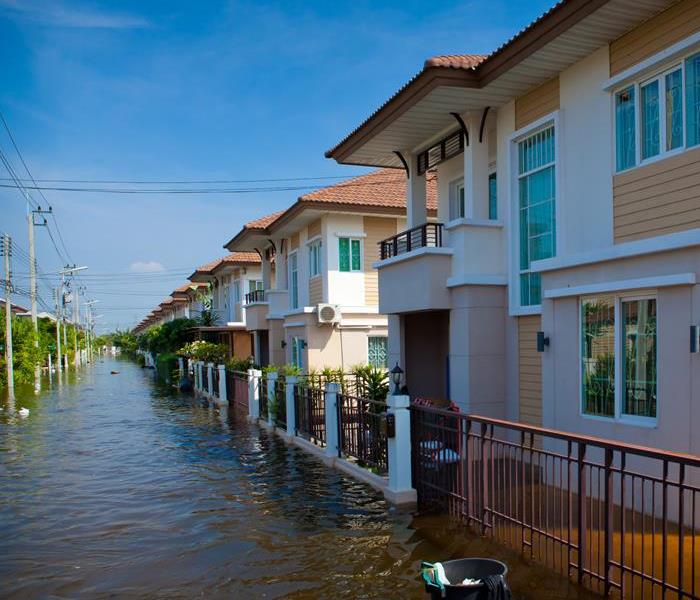 if you experience flooding outside high-risk areas, do not hesitate to contact us.
if you experience flooding outside high-risk areas, do not hesitate to contact us.
Many homeowners are not located in high-risk areas, meaning flood insurance is not a requirement of ownership. However, being outside of a flood zone or plane does not mean flooding is impossible.
Advices to consider if you experience flooding outside high-risk areas
Many people experience flooding outside of high-risk areas every year. Unfortunately, these homeowners typically have to foot the bill for a restoration service in Bountiful, UT. Water damage is not cheap, and it can include costs for several tasks:
- Mitigation
- Cleanup
- Disinfection
- Restoration
What To Do When You Don't Have Flood Insurance
Homeowners who experience flooding without the appropriate insurance policies may not have the funds to restore the house correctly. They might feel like the only option is to move or slowly work to make repairs.
The slower people react to water loss, the more damage can occur, including mold infestations. Water can also compromise the house structure, making it dangerous to inhabit.
If you experience flood loss without insurance, you are not out of luck or without possible help. Federal and state programs exist for natural disaster relief. Additionally, there are nonprofit organizations that are willing to help qualified individuals. You only need to know where to look and who to ask for help.
Check for Federal Disaster Relief
After a major disaster, the first place you should look for relief is FEMA or the federal government. Depending on the event and its rarity, the federal government might declare your area a disaster zone.
As a disaster zone, you and your neighbors might be eligible for some financial relief through FEMA. The relief can come in the form of grants or loans. Your specific situation will likely play a role in the type of relief you qualify for.
If your area is deemed a federal disaster zone, you can contact your local city manager or county clerk to determine the best way to apply for assistance.
Look To the State or Other Nonprofits
Even if the federal government does not offer assistance, you can look to your state. The state and local government might provide disaster relief to qualifying individuals.
It might be best to contact city officials to determine the type and amount of aid you qualify for. In most disaster situations, the city will designate specific contacts and officials that can help dispatch aid.
Beyond city and state government, you can also look to local nonprofit organizations. While nonprofits might not offer financial assistance, they might provide food or labor assistance. Essentially, when a disaster occurs, it is best to call city managers to find out the best path forward.
While flood insurance is not a requirement for every homeowner, it might be a worthwhile investment. However, even if you do not have insurance, there might be other opportunities for financial assistance and other forms of help. City managers are often the best people to talk to about disaster relief.
What Happens After Water Damage?
10/18/2021 (Permalink)
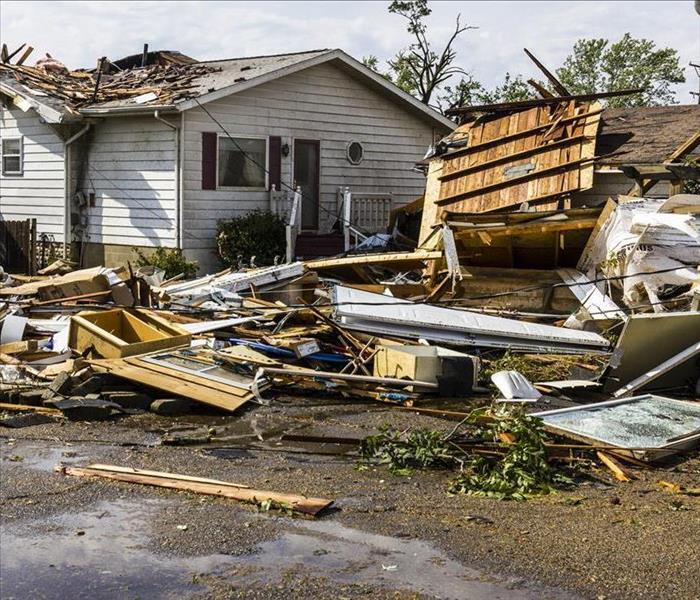 A severe storm can damage your home in Bountiful, UT.
A severe storm can damage your home in Bountiful, UT.
Severe storms can transpire at any time of the year in Bountiful, UT. It's important to know what to do beforehand in case your home is subjected to a powerful storm, especially one that carries an influx of water into the house. Several serious issues can arise just from the excess moisture, such as:
- Soaked, stained drywall
- Destroyed insulation
- Ruined carpet and padding
- Rotting wood
- Mold growth
- Pungent odors
These problems will require quick action involving tear out of ruined materials and thorough drying to mitigate the loss.
What Are the Storm Restoration Procedures?
Post-storm, it's critical to put safety first. Before beginning any of the following steps, make sure you can safely navigate the area and take care of any emergency restoration that you can safely handle yourself.
1. Contact Your Homeowners Insurance
Call your homeowners insurance company as soon as possible to begin the claims process. An adjuster may need to come out and assess the damage before restoration can begin. In the meantime, take photos of all of the damage to give to your agent.
2. Check Electrical
Before going into the area, the safest option is to turn off electricity to the house. Electrical currents can flow through standing water, seriously injuring anyone who steps into it. If you can't safely navigate to the breaker box to turn it off, call your power company or an electrician before proceeding. Once the power is turned off, unplug water-exposed electronics and appliances from their outlets.
3. Deal With Flooding
Standing water indoors is best left to water damage remediation professionals. They have the expertise and industrial equipment to complete the restoration thoroughly and as quickly as possible. While you're waiting for the technicians to arrive, you can mitigate damage by beginning the water removal process. A wet/dry vacuum will be the safest and most efficient method, but mops and towels will do if you don't have access to one. You can also begin the tear-out process by removing materials from the area, such as soaked carpet, padding, and drywall. Also, you must remove as many of the contents as possible to make room for the technicians to complete the restoration process. After removing them from the area, you can determine if each item is salvageable or not.
4. Check the Roof
Check your roof to see if you notice any holes or missing shingles. Unless you have experience, it's best to let a professional contractor get on the roof to inspect the damage and make any repairs. They may have to tarp it temporarily to protect the home from further damage until they can permanently repair it.
If your home is affected by a major storm, you're likely to have a significant loss that will take time, expertise, and the proper restoration tools. Unfortunately, it's not as simple as extracting the water; it'll probably involve tear out, sanitizing, and extensive drying. It could involve much more if mold has begun to grow. It's vital to be proactive and learn the basic steps should you endure one of these disasters in the future.
Flood Safety Tips Every Homeowner Should Know
9/27/2021 (Permalink)
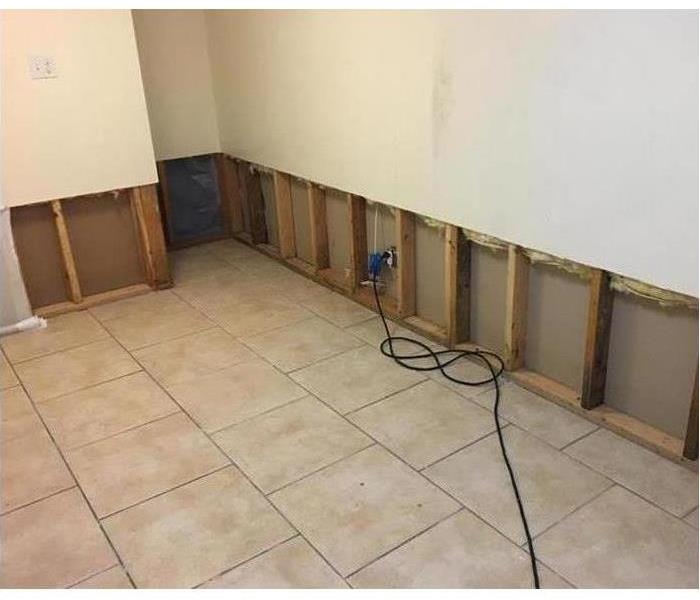 Following these tips will make it easier to face a flooded home.
Following these tips will make it easier to face a flooded home.
You read and hear about disasters on the news, but you may never think they’ll happen to you. However, disastrous incidents such as flooding can occur anywhere in Bountiful, UT, and beyond. Though it’s impossible in all circumstances to control when a flood will affect you, there are ways you can prepare for flood safety. If you practice a few simple tips, you could save yourself a significant of time, money, and grief.
Flood safety tips
Before a Flood.
Flooding can be an issue due to several factors, including intense weather, poor plumbing, sewage backup, and others. No matter what you do, you can’t keep the weather away, but you can do some things to minimize damage.
- Clean your rain gutters
- Seal basement vents
- Examine windows and make sure they don’t have gaps
- Have a trained professional examine your plumbing and sewage systems
- Secure valuables in waterproof containers or safe deposit boxes
During a Flood.
If water starts making its way into your home, it’s essential that you avoid contact with it. Of all the safety tips, one of the most critical is that you stay away from black water, which contains sewage and other potentially fatal materials. You should also turn off your home’s power and water mains. Also, never use an appliance that has come into contact with floodwater. It’s important to pay attention to instructions from local authorities on how to safely react to flooding.
After a Flood.
Flood safety is just as important following the incident as it is during. Once the water is under control, you need to clear it out as soon as possible. You should do this with a wet vacuum. Make sure you dry the area and sanitize thoroughly as well. A restoration specialist will determine whether you need to replace the flooring, walls, or other areas.
If you practice good flood safety, you can avoid damage to your home and injury to yourself and your loved ones. Keep these guidelines handy and implement them today.
What To Do When You Have Storm Damage
7/14/2021 (Permalink)
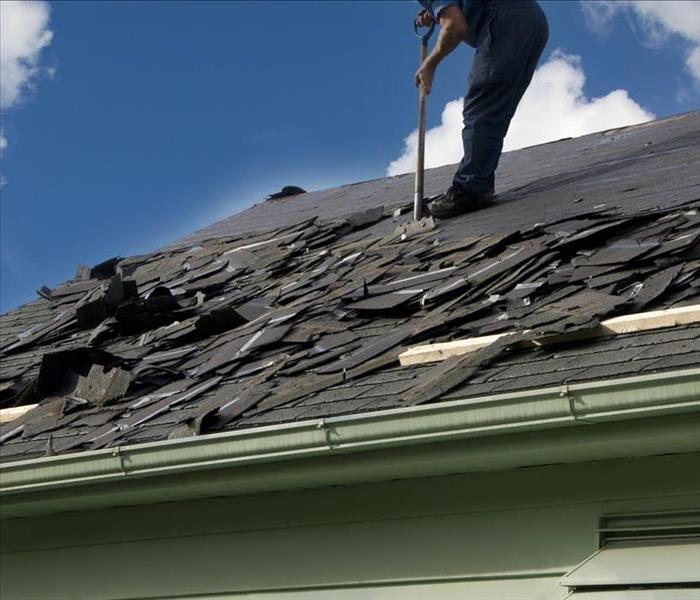 Residential roof replacement for storm damage in Bountiful, Utah.
Residential roof replacement for storm damage in Bountiful, Utah.
A common cause of roof damage in homes in Bountiful, Utah, is fallout from storms. Problems with your roof can easily lead to issues inside your home as well. After the storm passes, there are several things that must happen during mitigation to ensure that your home is protected.
Find Weak Spots
Even if your roof is in great shape before a strong thunderstorm, you should always have it checked by a professional afterward. There are several elements that can cause damage to your roof during a storm:
Experienced professionals know where to look for the common signs of wind damage to shingles. They make note of the cracks or chips caused by hail and other abrasive elements. A thorough inspection reveals all the areas that need mitigation.
Clean Gutters
Storms are likely to leave a lot of debris lying around. Some of the twigs, dirt, and leaves that get redistributed may end up clogging your gutters. While cleaning out gutters and downspouts should be a regular part of your home maintenance routine, cleaning them out after a heavy storm, particularly one that involves high wind gusts, helps prevent further roof damage.
Board Up Holes
If your home has extensive damage, it may take a few weeks for the roofers to fix it. In the meantime, storm mitigation experts typically put tarps or boards over the most vulnerable areas while they are working on the water damage and other structural issues caused by the storm. This keeps out additional rain and debris, and it keeps animals or other invaders from entering your house through the damaged areas.
Getting your home back to normal after a storm may take time and a team of specialists, but it's possible. Hiring professionals to help find all the roof damage, clear out debris and protect your home from further issues is the key to quick mitigation.
My Flight Was Canceled Because of Weather. Now What?
5/28/2021 (Permalink)
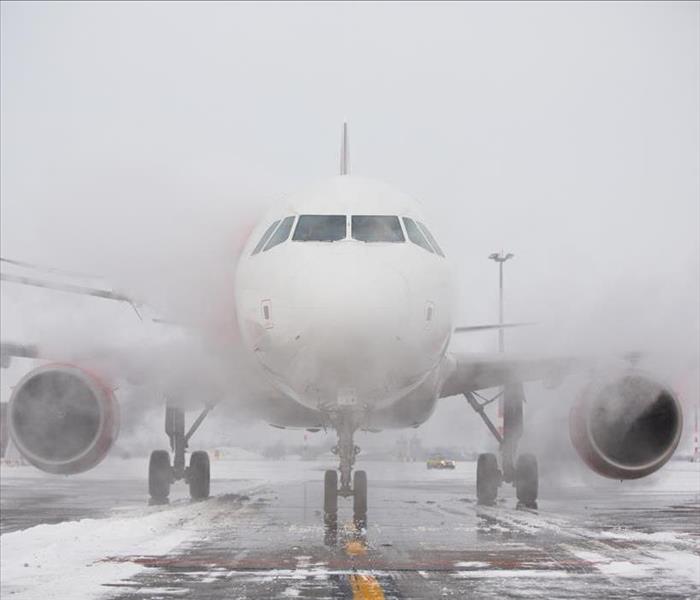 Canceled flights require patience
Canceled flights require patience
Everything that comes with traveling by air can cause stress and anxiety but even more so when your flight is unexpectedly canceled due to inclement weather. A canceled flight can test your patience and leave you wondering what's next. Follow these tips if you get stuck on the ground in Bountiful, UT.
4 Tips For a Canceled Flight Due to a Storm
1. Call Before You Leave Home
If you discover that your flight has been canceled before you leave home, you may be able to save some time and handle it without going to the airport. Check the airline's website or for their rescheduling policy. If it's less than 24 hours before the original departure time, you can ask about rescheduling without the typical fees for changing flights.
2. Keep Airline Phone Numbers Available
If your flight gets canceled after you're at the airport, you may be able to book a later flight. Depending on the type of inclement weather, it may pass so that flights will resume relatively soon. Call different airlines while you're at the airport in case the original canceled flight isn't rescheduled soon enough. Some airlines will handle this for you.
3. Practice Patience
If the bad weather is around a while, you could have to wait days until the next available flight. If it's going to be at least one night and you're stranded at the airport, sometimes airlines will issue vouchers for meals and even local hotel stays.
4. Check With Customer Service Regularly
As you're waiting on the next phase of your journey, it's beneficial to make yourself comfortable close to customer service. Here, you'll be able to check with agents regularly to see when they begin booking again.
Being stuck at the airport due to a canceled flight can cause significant problems for you and ruin your plans. Besides, incurring storm damage at your home requiring you to contact water damage restoration experts before your trip could cause additional stress. Unfortunately, sometimes the unavoidable happens, but hopefully, these storm tips will help keep you moving.
3 Things Not To Do After a Flood
2/24/2021 (Permalink)
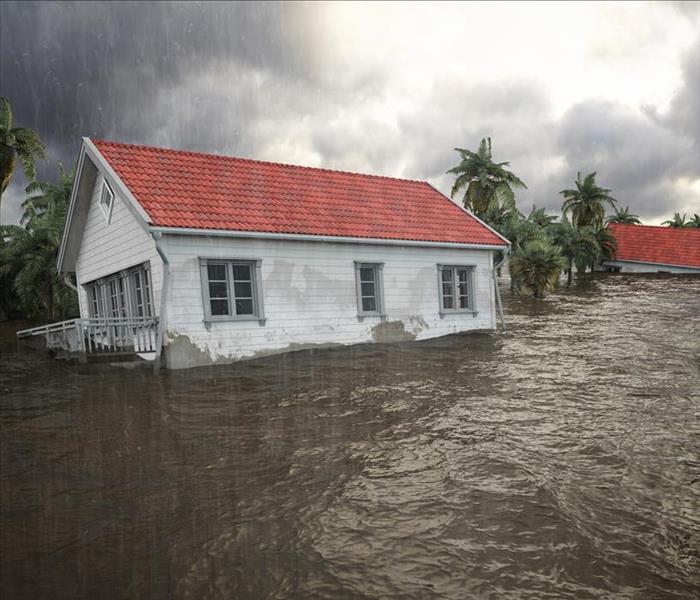 Deal with flood water properly.
Deal with flood water properly.
Floods can pose serious risks to people and property. When dealing with flood water, it is important to avoid common mistakes that can put your safety at risk or lead to unnecessary damage to your property. These are three things you should not do after a flood.
3 Things to Avoid After a Flood
1. Try To Be a Hero
If you know a flood is imminent, or you have been ordered to evacuate by authorities, do not try to save your flooded home. While some actions, such as placing sandbags, may protect your home from minor flooding, there isn't much you can do to save your home from a major flood. Staying in your home puts you and anyone who has to come to rescue it at risk. It is better to evacuate to a shelter, or rent a hotel room or stay with friends or family in an area not affected by the flood.
2. Walk or Drive Through Standing Water
It is best to avoid walking or driving into flood water. As little as six inches of water can create problems for drivers. Additionally, standing water from floods may contain contaminants from sewage or be electrically charged due to downed power lines. If you do need to walk through water, wear rubber boots to protect yourself from shocks.
3. Allow Your Property To Stay Wet
You shouldn't attempt to return to your home before you've been told that it is safe, but as soon as you get the go-ahead you should begin efforts to dry out your property. You may want to contact a water damage remediation company in Bountiful, UT, to dry out your home quickly. The longer your property remains wet, the higher the chance of problems such as mold, mildew and rot is to occur.
Flooding can create havoc in your home. Dealing with flood water properly can help ensure your family stays safe and your home sustains as little damage as possible.
Why You Need Roof Damage Mitigation After a Storm
1/26/2021 (Permalink)
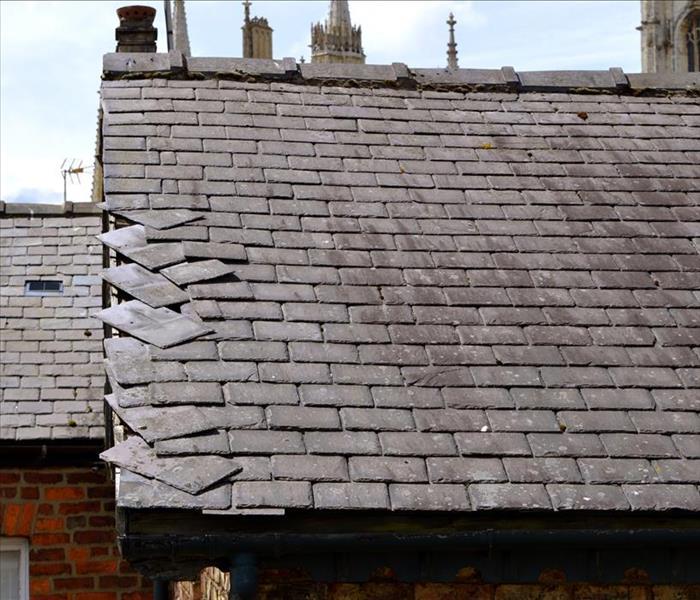 You may need roof damage mitigation after a storm.
You may need roof damage mitigation after a storm.
Although many people are well aware of what a powerful storm can do to their roof, they are not aware of the additional damage that can happen after a storm. Roof damage does not stop just because the storm has ended. Even a gentle rain can add thousands in water damage, and a light wind can pull loose roofing materials down. Fortunately, there are damage mitigation companies that can help you prevent this from happening.
3 Reasons to Mitigate Roof Damage After a Storm
What a Damage Mitigation Company Does
What storm and wind damage mitigation company does is simple. They:
- Document the damage
- Remove debris
- Cover holes and breaks
- Help you plan on how to correct the damage
They understand the individual dangers of Bountiful, UT and best know how to keep more roof damage from occurring.
Your Insurance Might Require It
Although it depends on your individual company, you may not be able to file a claim if you do not hire a mitigation company. The insurance company will want to minimize how much they have to pay for the repairs. They can only do this by making sure more problems don't happen while they are assessing the initial storm damage.
It Gives You Time
Immediately patching the problem can give you more time to decide exactly how you want to handle the repairs. If the damage is minor, you might just want to hire a company on your own to have it fixed. If it is major, you might want some more time to select the best options for you and your home. In either case, it allows you a bit more time to assess the wind damage and make a plan to correct it properly.
Roof damage is devastating to a home's exterior and interior surfaces. Not only do you have problems with the actual roof, but each additional day can also cause more problems for the interior of your home. The very next rainstorm can cause serious and costly issues. Mitigation prevents this from happening.






 24/7 Emergency Service
24/7 Emergency Service














